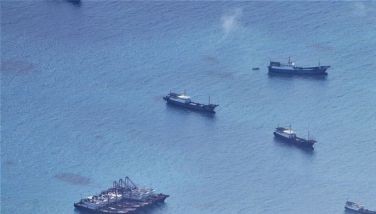China air zone plan a provocative act – US
WASHINGTON – The US State Department on Friday expressed concern over reports China is planning to implement a new air defense identification zone (ADIZ), this time over the South China Sea, and urged Beijing not to do so.
“We would consider such an ADIZ over portions of the South China Sea as a provocative and unilateral act that would raise tensions and call into serious question China’s commitment to diplomatically managing territorial disputes in the South China Sea,†de-puty spokesperson Marie Harf said at a press briefing.
“We have made very clear that parties must refrain from announcing an ADIZ or any other administrative regulation restraining activity of others in disputed territories and we would of course urge China not to do so,†she said.
In Manila, Presidential Communications Operations Office Secretary Herminio Coloma Jr. said the government will verify China’s plan reported by Japan’s Asahi Shimbun.
“Since this is still in the realm of conjecture, it is best we await official announcement and DFA’s (Department of Foreign Affairs’) official response,†Coloma said.
He said the Philippines is firm on its call for freedom of navigation and aviation in the region.
Harf was also commenting on the Asahi Shimbun report.
The Asahi Shimbun in a report on Friday said that working-level air force officials in China “have already worked out a draft plan for the prospective†ADIZ for the South China Sea.
The Japanese newspaper said the “Air Force Command College, a cadre development and research institution in Beijing that helped draft the East China Sea ADIZ,†has been working on the South China Sea ADIZ for some time now, and submitted an original draft plan to senior military leaders as early as May 2013.
China imposed an ADIZ in the East China Sea in late November 2013 in an area that includes islands, called Senkaku by Tokyo and Diaoyu by Beijing, at the heart of a bitter territorial dispute with Japan.
A new ADIZ in the South China Sea and the problems it could pose to busy air traffic lanes can only worsen tensions in the region.
Beijing claims almost all of the South China Sea, which is said to be rich in oil and gas, rejecting rival claims to parts of it from the Philippines, Vietnam and Malaysia, among others.
While the US itself is not a claimant, it says it has a stake in the freedom of navigation in the busy sea lanes, which are crucial to world trade.
Establishing a South China Sea ADIZ would be consistent with China’s recent increased naval patrols of the South China Sea, analysts said.
The Asahi Shimbun report said Chinese officials were still discussing the exact coverage of the planned ADIZ in the South China Sea.
According to Asahi’s sources, some Chinese officials advocate having it cover the entire South China Sea while others are suggesting it only go as far as the Paracel Islands.
The precise dimensions of the ADIZ will be important for at least two reasons. First, a more encompassing ADIZ claim would antagonize more of China’s Southeast Asian neighbors, raising the possibility that the Association of Southeast Asian Nations (ASEAN) will be able to unite internally in standing up to China in the South China Sea issue. By contrast, a narrower ADIZ might allow China to continue isolating certain countries like the Philippines and Vietnam.
Second, the exact size of the ADIZ is also important in terms of China’s ability to enforce the rules it establishes. The People’s Liberation Army Air Force (PLAAF) lacks enough aircraft with sufficient range to effectively enforce an ADIZ further out in the South China Sea, making it much easier for even smaller nations to openly defy China’s regulations. By contrast, a smaller ADIZ might give the PLAAF a better chance of making the ADIZ more than just Beijing staking a future claim to the area, the newspaper said. – With Aurea Calica
- Latest
- Trending































